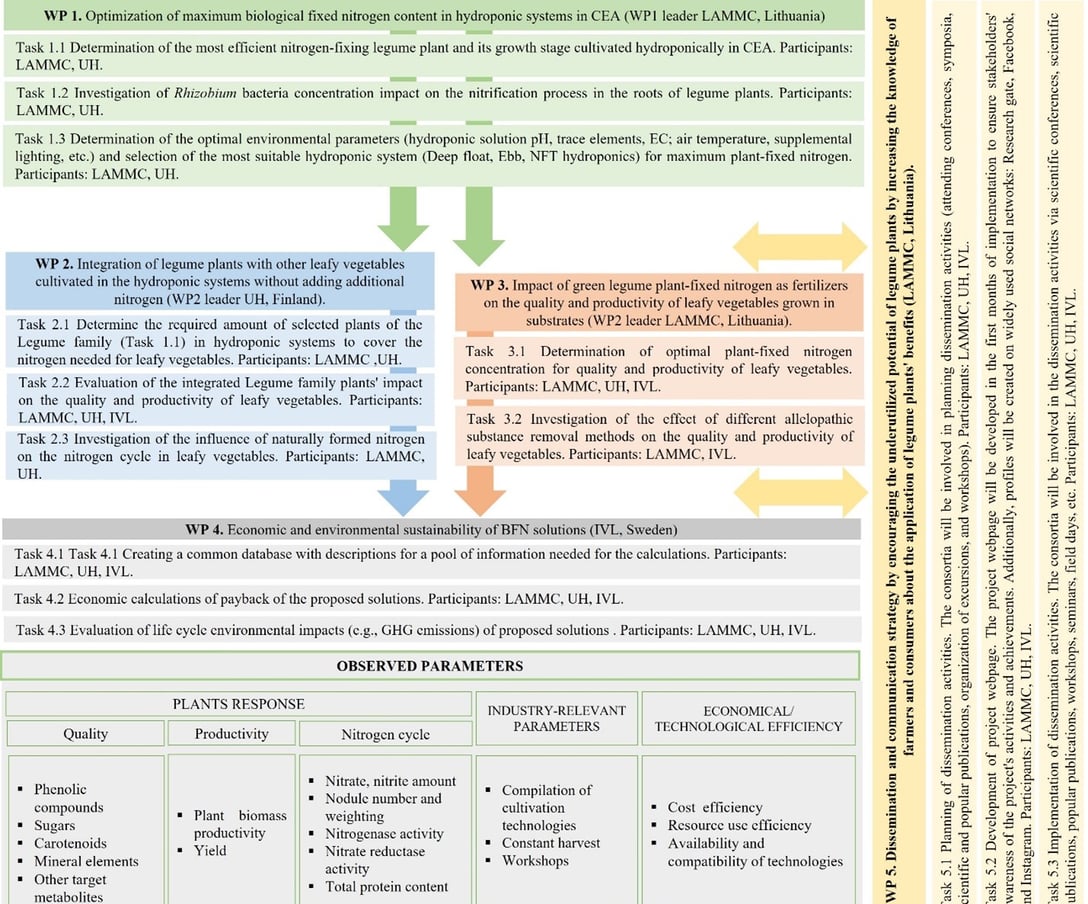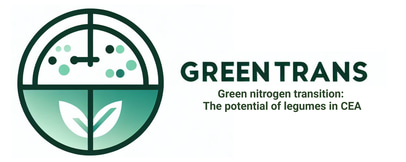Work packages
WP1: Optimization of maximum biological fixed nitrogen content in hydroponic systems in CEA (WP1 leader LAMMC, Lithuania).
Objectives: Elaboration of the most effective growing technology for obtaining the highest amount of biologically fixed nitrogen that can change the synthetic nitrogen in Baltic-Nordic region agricultural practice and reduce greenhouse gas emissions. This will be achieved by adapting leguminous plants to CEA, selecting the most suitable environmental conditions, the amount of Rhizobium bacteria, and evaluating the influence of allelopathic substances, and such a hydroponic solution enriched with biologically fixed nitrogen will be intended for use in cultivated plants grown in the fields.
Description of work: Experiments will be carried out in CEA in greenhouses and growing chambers with different hydroponic systems. The systems, methods, and plants (peas, lentils, beans, soybeans, and/or etc.) showing the highest amount of BFN will be selected for further studies. All tasks will be achieved through analysis of the entire nitrogen cycle. Also, during specific plant growth periods, which depend on the plant variety, the amount of nitrogen in the plant's hydroponic solution, roots, and leaves will be measured, and nodule formation, nitrogenase, and nitrate reductase activity will be evaluated. Carry out calculations that would estimate the amount of biologically fixated nitrogen, show profitability, and reduction of GHG emissions. Also, evaluating allelopathic substances (Such as lactic acid, benzoic acid, p-hydroxybenzoic, vanillic acid, adipic acid, succinic acid, malic acid, glycolic acid, salicylic acid, malonic acid, p-hydroxy-phenylacetic acid) that may influence other plants, and methods (Amberlite XAD4 20-60mesh, activated charcoal) for their removal (Talukder et al., 2020).
Task 1.1 Determination of the most efficient nitrogen-fixing legume plant and its growth stage cultivated hydroponically in CEA (LAMMC, Lithuania). Participants: LAMMC, UH,
Task 1.2 Investigation of Rhizobium bacteria concentration impact on the nitrification process in the roots of legume plants (LAMMC, Lithuania). Participants: LAMMC, UH,
Task 1.3 Determination of the optimal environmental parameters (hydroponic solution pH, trace elements, EC; air temperature, supplemental lighting, etc.) and selection of the most suitable hydroponic system (Deep float, Ebb, NFT hydroponics) for maximum plant-fixed nitrogen (LAMMC, Lithuania). Participants: LAMMC, UH,
Task 1.4 Identify the amounts of formation of the main allelopathic substances and methods of removal (LAMMC, Lithuania). Participants: LAMMC.
WP 2: Integration of legume plants with other leafy vegetables cultivated in the hydroponic systems without adding additional nitrogen (WP2 leader UH, Finland).
Objective: Incorporating legumes into hydroponic systems where leafy vegetables are grown, considering their required amount, and ensuring sufficient nitrogen content, which would determine the quality and productivity of leafy vegetables.
Description of work: The selected legumes and their cultivation techniques that gave the best results will be used in these experiments. Selected legumes will be integrated to grow in hydroponics along with the most popular leafy vegetables (Various types of lettuce, kale, leafy beets, etc.) in CEA. The quality of leafy vegetables will be investigated using chromatographic (sugars, polyphenols, carotenoids), spectrophotometric (antioxidants, total protein content; nitrate, nitrite amount), and spectrometric (micro-, and macro-elements) methods. The productivity of leafy vegetables will be assessed by measuring leaf area and weighing green and dry biomass.
Task 2.1 Determine the required amount of selected plants of the Legume family (Task 1.1) in hydroponic systems to cover the nitrogen needed for leafy vegetables (UH, Finland). Participants: LAMMC, UH,
Task 2.2 Evaluation of the integrated Legume family plants' impact on the quality and productivity of leafy vegetables (UH, Finland). Participants: LAMMC, UH, IVL.
Task 2.3 Investigation of the influence of naturally formed nitrogen on the nitrogen cycle in leafy vegetables (UH, Finland). Participants: LAMMC, UH,
WP 3: Impact of green legume plant-fixed nitrogen as fertilizers on the quality and productivity of leafy vegetables grown in substrates (soil, peat, etc.) (WP3 leader LAMMC, Lithuania).
Objective: After evaluating the amount of biologically fixed nitrogen in the hydroponic solution, adjust its concentration and evaluate the possible negative effects of root exudates in vegetative experiments.
Description of work: The experiments will be performed in CEA, and appropriate concentrations of the potentially accumulated amount of biological nitrogen will be selected (at least 3) for vegetative experiments. Thus, an individual experiment will be dedicated to evaluating the effects of allelopathic substances. The quality of leafy vegetables (Different species and/or cultivars of lettuce, kale, leafy beets, spinach, etc.) will be investigated using chromatographic (sugars, polyphenols, carotenoids), spectrophotometric (antioxidants, total protein content), spectrophotometric (antioxidants; nitrate, nitrite amount) and spectrometric (micro-, and macro-elements) methods. Productivity will be assessed by measuring leaf area and weighing green and dry biomass.
Task 3.1 Determination of optimal plant-fixed nitrogen concentration for quality and productivity of leafy vegetables (IVL, Sweden). Participants: LAMMC, UH, IVL.
Task 3.2 Investigation of the effect of different allelopathic substance removal methods on the quality and productivity of leafy vegetables (IVL, Sweden). Participants: LAMMC, IVL.
WP 4: Economic and environmental sustainability of BFN solutions (IVL, Sweden).
Objectives: Assess the environmental and economic performance to study the viability of the solutions
Description of work: Based on experimental analyses, prospective assessments (both economic and environmental) will be performed employing life cycle costing and life cycle analysis to ensure that proposed solutions are environmentally and economically sound. All activities will be carried out using a commonly agreed methodology, developed descriptors, and shared database so that all partners can use all the information gathered by the project.
Task 4.1 Creating a common database with descriptions for a pool of information needed for the calculations (LAMMC, Lithuania). Participants: LAMMC, HU, IVL.
Task 4.2 Economic calculations of payback of the proposed solutions (LAMMC, Lithuania). Participants: all.
Task 4.3 Evaluation of life cycle environmental impacts (e.g., GHG emissions) of proposed solutions (IVL, Sweden). Participants: LAMMC, HU, IVL.
WP 5: Dissemination and communication strategy by encouraging the underutilized potential of legume plants by increasing the knowledge of farmers and consumers about the application of legume plants' benefits (LAMMC, Lithuania).
Objectives: Promoting the use of underutilized pulses in hydroponics by educating farmers and consumers on their benefits through targeted dissemination activities. This will involve sharing non-confidential information on the GreeNTrans project's activities, results, and achievements to increase awareness of the research results. Ultimately, the scientific findings will help raise awareness of these pulses and encourage their increased use in hydroponics.
Description of work: The results of the GreeNTrans project will primarily be disseminated to stakeholders in the Nordic-Baltic region, as well as throughout the EU and worldwide, in order to integrate and apply new knowledge in practice. The possible stakeholders in GreeNTrans project are policymakers, scientists, educators, producers (farmers), consumers and their associations, food, manufacturing and processing companies. All members of the consortium will actively participate in dissemination activities and contribute to their communication networks.
Task 5.1 Planning of dissemination activities. The consortia will be involved in planning dissemination activities (attending conferences, symposiums, scientific and popular publications, organizing excursions, and workshops). (LAMMC, Lithuania). Participants: LAMMC, HU, IVL.
Task 5.2 Development of project webpage. The project webpage will be developed in the first months of implementation to ensure stakeholders' awareness of the GreeNTrans project's activities and achievements. Additionally, profiles will be created on widely used social networks: Research Gate, Facebook, and Instagram. (LAMMC, Lithuania). Participants: LAMMC, HU, IVL.
Task 5.3 Implementation of dissemination activities. The consortia will disseminate the activities via scientific conferences, scientific publications, popular publications, workshops, seminars, field days, etc. (LAMMC, Lithuania). Participants: LAMMC, HU, IVL.


GreeNTrans project is organized in 5 work packages (WPs), closely related and interacting with each other to cover the full spectrum of activities and to use the advantages of collaboration. Project management and dissemination are performed in close partnership and in accordance with the objectives of the project and particular WP. Methodology and materials are provided below for each task.
